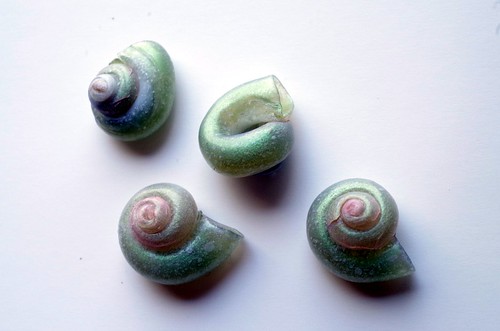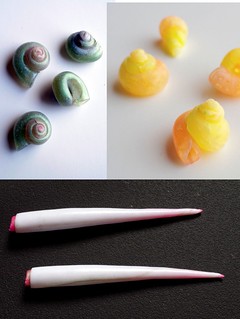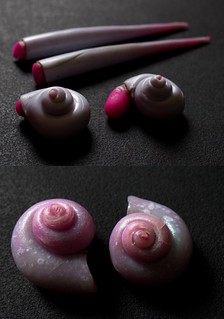The bead is basically a bull's eye cane with a fine outer layer of polymer clay and a larger playdoh core that has been rolled into a cone and then unto itself.

Disclaimer: I have had no problems baking playdoh at the temperatures at which polymer clay is normally baked. However, I do not know how it behaves at higher temperatures, or when baked for a very long time (more than an hour or two). Use caution like you would for any inclusion material.
The bead is basically a bull's eye cane with a fine outer layer of polymer clay and a larger playdoh core that has been rolled into a cone and then unto itself.
The green ones are based on a simple sheet of clay with green Perfect Pearls powder on one side (the inside of the cone, so it is protected from abrasion).
The orange ones are a remainder of the playdoh cane from the plancton beads.

I used pardo clay, which is very strong even in a fine layer, but you could try other clays.
Prepare a fine sheet of clay (the finest that you can manipulate easily without tearing), and a cylinder of playdoh. Create a bull's eye cane, taking care to join correctly the two edges where the polymer sheet meets itself.
Roll in a long cone, and then roll the cone into a snail shape, taking care to hide the suture between the two edges of the sheet against the axis of the spiral. I did not always do it, and it shows (as does some awful plaquing).

You can stabilize with a heat gun first, or bake directly. It is important to bake very well, because the sheet is very fine and needs to be strengthened. The pink shells just above were baked again to get full translucency of the clay, so the green Perfect Pearls inside would become visible.
Now comes the longest part.
Using a toothpick or another fine tool, get out as much playdoh as you can. Soak in water for several hours, repeat. You cannot access the inner spires with a straight tool, but you can use something flexible with a hard end to help convince the water soluble clay to come out: a piece of fine and soft wire, or of strong fishing line. Running water helps too.
When the spires are empty, dry well, and use as desired.
Linked posts (some to come, but available already on Flickr):
Playdoh cane

Hollow beads using water-soluble child clay

Faux wood playdoh cane

I believe in sharing. I have learned most of what I know about polymer clay, and many other subjects, from the web, so giving back seems the right thing to do.
You are very welcome to use these techniques, and even sell the result. However, I would much appreciate a mention and a link if you use these techniques.
And I would love to see anything you have done with this...
Aucun commentaire:
Enregistrer un commentaire